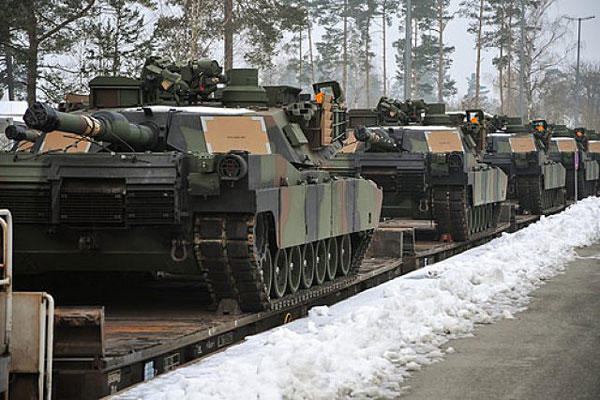The new Army commander in Europe plans to bolster the U.S. armored presence in Poland and the Baltic states and keep rotations of U.S. troops there through next year and possibly beyond to counter Russia.
Lt. Gen. Frederick "Ben" Hodges, who replaced Lt. Gen. Donald M. Campbell earlier this month as commander of U.S. Army Europe, said the Army was looking to add about 100 Abrams tanks and Bradley Fighting Vehicles to the forces in Eastern Europe.
"We are looking at courses of action for how we could pre-position equipment that we would definitely want to put inside a facility where it would be better maintained, that rotational units could then come and draw on it and use it to train, or for contingency purposes," Hodges said in a briefing from Vilnius, Lithuania.
Hodges visited a training site in Lithuania that could be used to store armor and said he would look at similar sites in Estonia and Poland.
"Certainly, I don't see a need to build infrastructure -- a FOB [Forward Operating Base] if you will -- or anything like that, that would be used for U.S. forces," Hodges said.
Since taking command, Hodges has made clear his concerns about Russia, which annexed Crimea last March and has supported the separatists in eastern Ukraine. U.S. Army Europe, which had 280,000 troops at the height of the Cold War, now has 31,000.
The rotations of U.S. troops on training missions in Eastern Europe would provide "deterrence against Russian aggression," Hodges said.
"I don't think that Russia has any intention of some sort of a conventional attack into NATO territory because they know that would generate an Article 5 response."
He referred to the NATO treaty article calling on all member states to respond to an attack on any member of the alliance. Poland, Lithuania, Estonia and Latvia are all members of the 28-member NATO alliance.
"I think that what they [the Russians] do want to do is to create that ambiguity, plant the seeds of uncertainty so that the alliance members lose confidence that the rest of the alliance would come to their aid if they were, in fact, attacked," Hodges said.
Two days after Hodges spoke, Air Force Gen. Philip Breedlove, the NATO commander, visited Ukraine to discuss U.S. and NATO assistance in shoring up defenses against the separatists.
Moscow has repeatedly denied sending troops into eastern Ukraine and providing advanced arms and equipment to the separatists, but Breedlove said that Russian troops definitely were present in eastern Ukraine and were "giving backbone" to the rebels.
Breedlove said Russian forces were also training the rebels to "understand the advanced weaponry that is being brought across."
The central government in Kiev led by President Petro Poroshenko has been pleading with the U.S. for advanced weaponry to counter the Russian troops and rebels, but the U.S. has limited assistance to non-lethal aid.
Speaking on background, a senior administration official traveling with Vice President Joe Biden on his trip to Ukraine last week said the U.S. has provided more than $100 million in non-lethal assistance "to help the Ukrainians defend themselves."
The aid included night-vision goggles;protective vests; counter-mortar radars; blankets; vehicles; and Meals, Ready to Eat, the official said. The official said the U.S. had concluded that arming Ukraine would be counter-productive since "no matter how many weapons we provided to Ukraine, they were going to get outgunned by the Russians."
Since the pro-Russian rebels seized border regions last April, more than 4,300 combatants and civilians have been killed in eastern Ukraine and nearly a million people have fled the region, according to the United Nations.






























